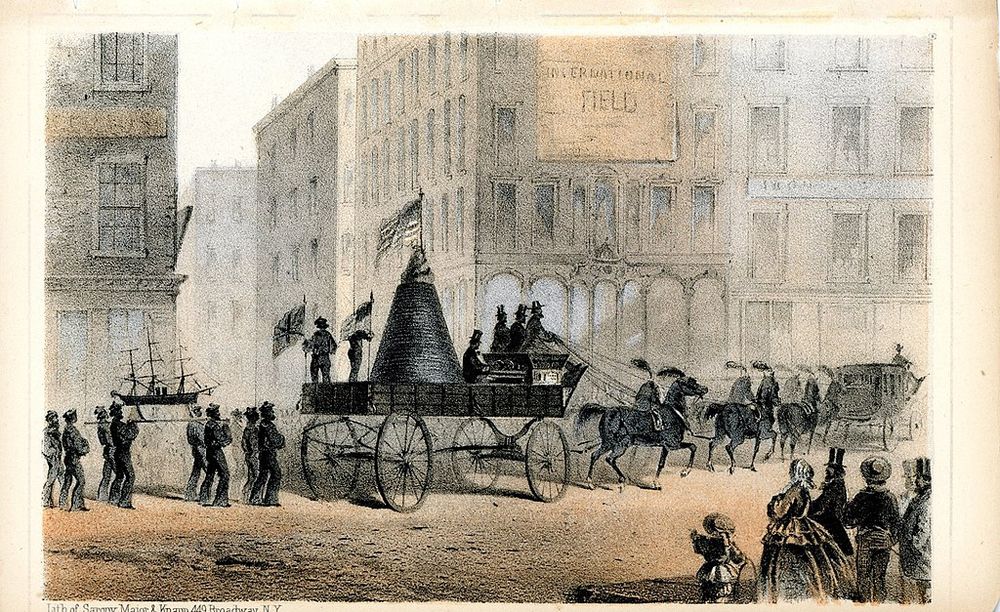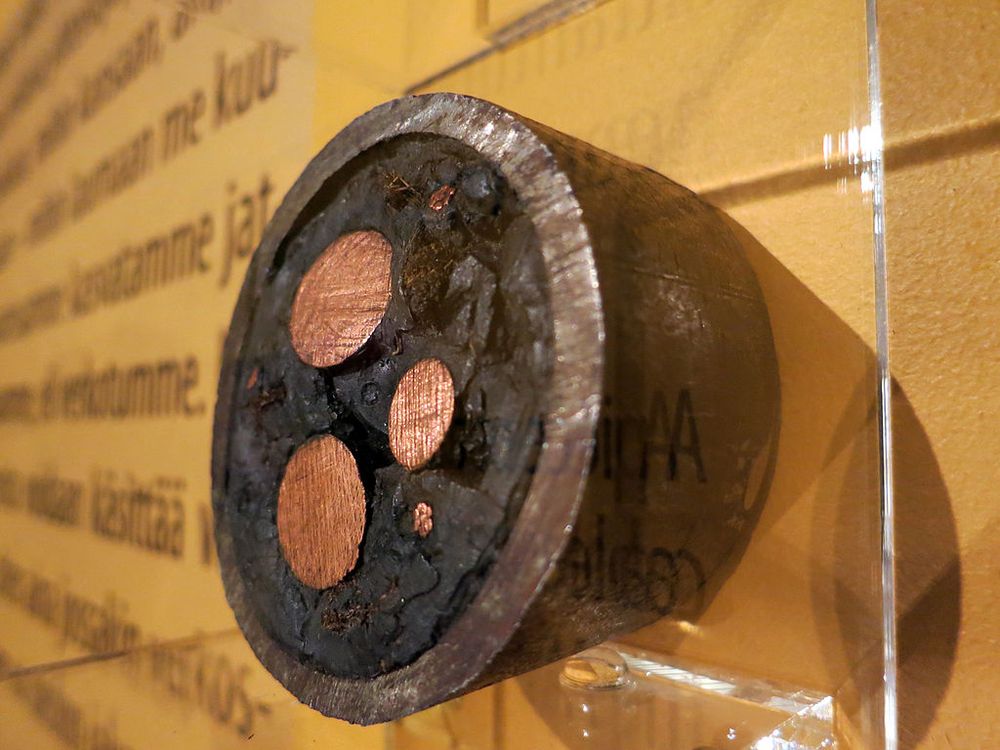Much of today’s lightning speed communication that happens between computer terminals or between mobile phones located in different continents is possible due to a network of communication cables that lie across the seabed. These submarine communication cables made of copper and fiber-optics are responsible for carrying nearly the entirety of all intercontinental communications traffic. They represent a major technological revolution, but these cables are not a new technology. In fact, the first intercontinental communication cable was laid more than 150 years ago when Queen Victoria was still alive.

Landing of the Atlantic Cable of 1866, Heart's Content, Newfoundland, by Robert Charles Dudley, 1866.
The idea of a submarine line across the Atlantic Ocean germinated as soon as William Cooke and Charles Wheatstone had demonstrated the first working telegraph in 1839. Samuel Morse even led a small trial in the water of New York Harbor by submerging a wire insulated with tarred hemp and India rubber, and telegraphing through it. Wheatstone also performed a similar experiment in Swansea Bay. Finding the right insulator was the key otherwise the electric current could leak into the water and diminish the strength of the signal. The gum of the Palaquium gutta tree, called gutta-percha, seemed to satisfy this requirement, and in 1847, an electrician of the South Eastern Railway submerged a 3 km wire coated with gutta-percha off the coast from Folkestone and tested it successfully.
By September 1851, the first telegraph cable across the English Channel was laid. More followed in the successive years linking Great Britain with Ireland, Belgium, and the Netherlands, and crossing The Belts in Denmark.
In 1854, New York businessman Cyrus West Field, who retired at the young age of 34 with a fortune of $250,000, sought out British engineer Frederic Newton Gisborne with a plan to lay a telegraph cable across the mighty Atlantic Ocean. Field contacted Lieutenant Matthew Maury, an authority on oceanography, who studied sounding records from logs of multiple ships and drew out a possible route across the Atlantic where the ocean bed was shallow. Maury named it the Telegraph Plateau. It was located approximately between south of Ireland and Newfoundland in Canada.

Cyrus West Field
That same year, Field persuaded four industrialists and engineers Peter Cooper, Abram Stevens Hewitt, Moses Taylor and Samuel Morse to join him and invest in a new company called the American Telegraph Company. Field became instrumental in laying a 400-mile telegraph line connecting St. John's, Newfoundland with Nova Scotia, coupling with telegraph lines from the U.S. Meanwhile, a group of American investors formed another company called the New York, Newfoundland, and London Telegraph Company (N.Y.N.L.T.C.) after Field convinced them to extend the line from Newfoundland to Ireland.
Field pushed the project ahead with tremendous energy and speed. Even before he had formed the company, he ordered 2,500 nautical miles of cable from the Gutta Percha Company. These cables were simple by today’s standards. They consisted of seven copper wires covered with three coats of gutta-percha and wound with tarred hemp, over which a sheath of iron wires was woven in close helix. It weighed more than 1 ton per nautical mile, but was relatively flexible, and could withstand tension of several tons.

Map of the 1858 Atlantic Cable route.
The plan was to use two warships—HMS Agamemnon and USS Niagara—each laying half the cable from both ends and then join them together in the middle of the sea. Cable laying started on August 1857. Field soon learned that laying cables under the sea was easier said then done. The cable broke while laying on the first day itself. It was grappled and repaired, but broke again, and the project was put on hold for the rest of the year. Problems with breakage continued to trouble them. Nevertheless, after one year and a raging storm that nearly sank the ships, the cable was laid and both ends spliced.
The first message was sent from Newfoundland on August 10, 1858. It read: “Directors of Atlantic Telegraph Company, Great Britain, to Directors in America:—Europe and America are united by telegraph. Glory to God in the highest; on earth peace, good will towards men.”
This was followed by a congratulatory telegram from Queen Victoria to President James Buchanan expressing hope that the cable would prove “an additional link between the nations whose friendship is founded on their common interest and reciprocal esteem.” The President wrote back through the same channel: “It is a triumph more glorious, because far more useful to mankind, than was ever won by conqueror on the field of battle. May the Atlantic telegraph, under the blessing of Heaven, prove to be a bond of perpetual peace and friendship between the kindred nations, and an instrument destined by Divine Providence to diffuse religion, civilization, liberty, and law throughout the world.”

H.M.S. Agamemnon Laying the Atlantic Telegraph Cable in 1858 by Robert Charles Dudley.
The first transatlantic cable had no repeaters to amplify transmitted signals, so by the time the messages reached the end, the signal was far too weak and overwhelmed with noise and thus hard to decipher. Queen Victoria's message of 98 words took sixteen hours to send. However, by the standards of the day when messages took weeks by sea, it was nearly instantaneous. The success of the first transatlantic cable was celebrated in New York City with a grand salute of 100 guns. Streets were hung with flags, bells of the churches were rung, and at night the city was illuminated.

A section of the Atlantic Cable paraded on the streets of New York on the 1st Sept. 1858. Lithograph by Sarony, Major & Knapp
Unfortunately, the celebration was short-lived. The cable lasted less than a month. Attempts to drive massive amount of current through the cable to compensate for signal losses resulted in insulation failure. When the news reached the press, some writers questioned whether there was in fact a cable, and the whole operation was a grand hoax.
Undaunted by the failure of the first cable, Field launched a second attempt backed by civil engineering contractor Thomas Brassey and politician John Pender, and formed a new company for laying a new cable. By this time cable engineering had vastly improved. The new cable that Field procured consisted of a core of pure copper, coated with an insulation material called Chatterton's compound, then covered with four layers of gutta-percha, alternating with four thin layers of the compound cementing the whole. This core was covered with hemp saturated in a preservative solution, and on the hemp were helically wound eighteen single strands of high tensile steel wire. The new cable weighed nearly twice the weight of the old, at 980 kg per kilometer.

Cable machinery on the deck of the Great Eastern, by Robert Charles Dudley.
The entire 2,300 nautical miles of this cable was loaded on to the ship SS Great Eastern captained by Sir James Anderson. On July 15, 1865, Great Eastern left the Thames estuary for Valentia Island in Ireland but after laying more than a thousand miles, the cable snapped near the stern of the ship, and the end was lost. The Great Eastern steamed back to England and began laying another cable, finally reaching Valentia Island. In 1866, after several attempts, the lost cable was found and retrieved from the ocean bed where it was spliced with a fresh cable, and the Great Eastern laid out this new cable all the way to Newfoundland, thus successfully linking the two countries across 1600 miles of ocean.
While the original cable of 1858 was abysmally slow, requiring two minutes to transmit a single character, message speed was vastly improved in the 1866 cable, which could transmit eight words a minute, or about 80 times faster than the 1858 cable. Over the next three decades, several more cables were laid between Valentia and Newfoundland owned by the British, French, German, and the Americans, creating a sophisticated web of telegraphic communications.

Memorial celebrating the landing site of the first transatlantic telegraph cable in Valentia Island. Photo: Ww2censor/Wikimedia

Piece of the first transatlantic telegraph cable on display at the Rupriikki Media Museum, Tampere, Finland. Photo: Trogain/Wikimedia












Comments
Post a Comment